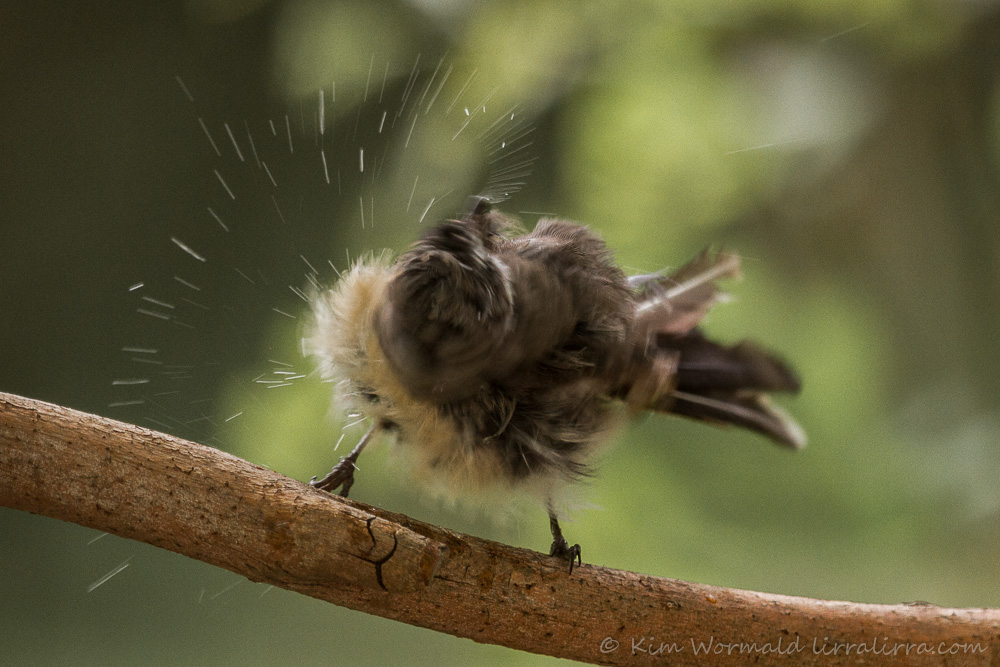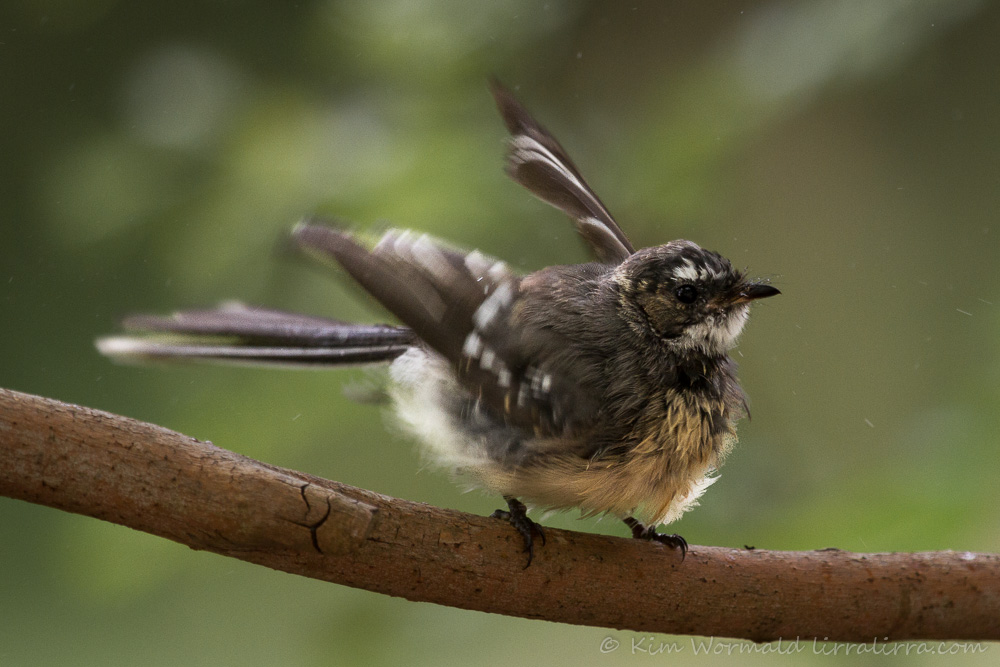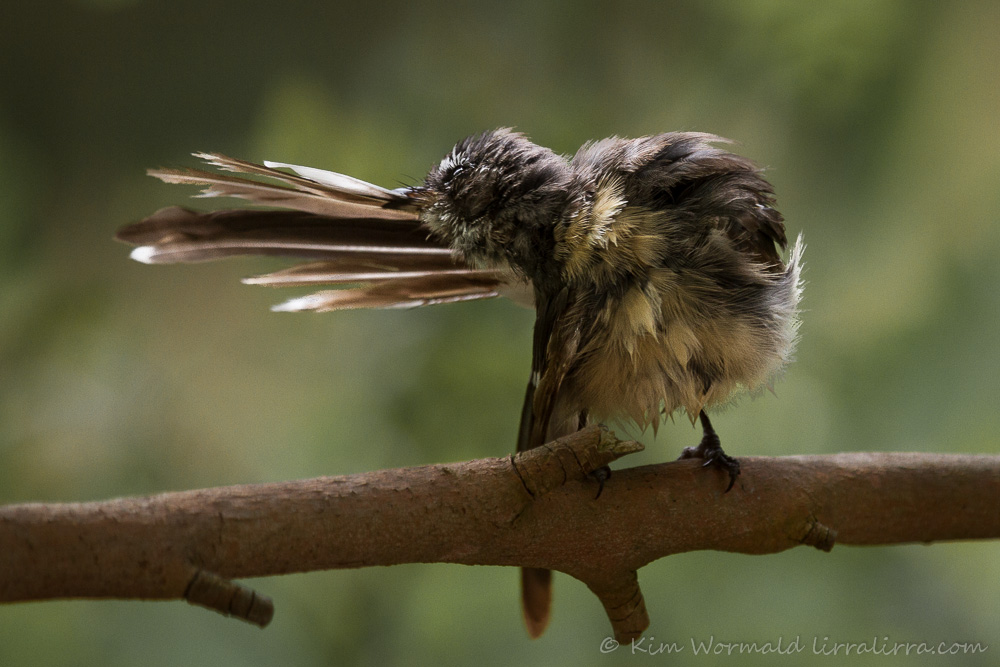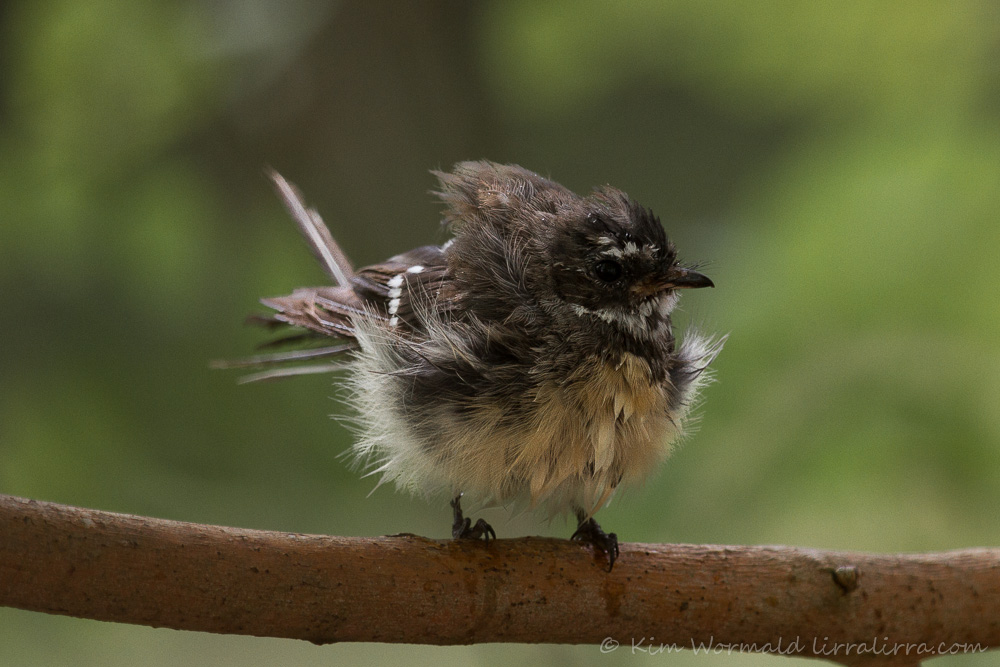This week’s first image breaks the cardinal rule of bird photography – ensuring that the eye is perfectly focused.

Grey Fantail – the after bath head shake
Canon 7D, 100-400mm L IS USM, 1/500, f/5.6, ISO 400, focal length 400mm
Birds seem to follow a set procedure after bathing. Even with a shutter speed of 1/500th of a second the fantail above was moving its head too quickly to freeze the action. I like the ‘star-trail’ spray of water droplets.

Grey Fantail – the after bath body shake
Canon 7D, 100-400mm L IS USM, 1/500, f/5.6, ISO 400, focal length 400mm
After the head shake comes the body shake. 1/500th of a second was fine for keeping the front of the bird focused but the booty wiggle was moving the other end way too fast.
 Grey Fantail – after bath preening
Grey Fantail – after bath preening
Canon 7D, 100-400mm L IS USM, 1/640, f5.6, ISO 250, focal length 400mm
Following the head shake and body shake comes the careful preening of feathers. During preening a bird can assume some comical positions as it uses its bill to remove dust, dirt and parasites, and ensure that its feathers are properly arranged. Most birds spread oil, from a gland near the base of the tail, to keep their feathers supple and waterproof. Other birds, including parrots, herons and some raptors, use powder down to keep their feathers in good condition. The powder comes from special feathers which disintegrate as they grow.
 Grey Fantail
Grey Fantail
Canon 7D, 100-400mm L IS USM, 1/500, f/5.6, ISO 320, focal length 400mm
After preening birds ruffle everything back into place – I love the ‘fluffy’ look.
 Grey Fantail
Grey Fantail
Canon 7D, 100-400mm, L IS USM, 1/500, f/5.6, ISO 320, focal length 400mm
And after all that busy abluting they deserve a little rest. Well it looks as though it’s resting but really it was doing the next thing on it’s personal care list and cleaning its bill on the branch, first one side and then the other.
This has been an exciting week and hopefully my next post will include improved images taken using a new piece of equipment!
Happy birding, Kim
NB It is possible to receive a weekly email informing you that lirralirra has been updated – just add your address to the ‘Subscribe to email’ box above right.
Also, I recently added a Facebook ‘like’ button – thank you ‘likers’.

I looked up the Northern Parula, what a beautiful bird! I can’t find your series online, could you send me the link, I’d love to see the images you mention.
Hi everyone, a recent update has improved some things but left me unable to reply to comments in the usual way. The awesome Joy is helping to sort it out so hopefully I’ll be able to answer your lovely comments soon.
Haha love the action shots
I wish they’d stay still a little longer! Thanks heaps for your problem solving help
wow, these are cute captures! And an adorable bird! Kim, have a happy weekend!
I’m glad you like them Eileen, a happy weekend to you too!
What a great way to start the day, mine I mean, although it may also be the fantails, one of my favourite species. Am enjoying seeing new birds in our present location on the Capricornia coast – Brahminy kite, crested terns, cattle egrets feeding at the feet of limousin cattle and black buzzards, I think.
Thanks Kim for providing us with such great photos and further education on our feathered friends.
Alison
Thanks for you lovely comment Alison. I would love to spend more time watching Brahminy Kites, they are incredibly beautiful, especially at sunrise and sunset when the light makes them look amazing. I’m glad you’re enjoying the Capricornia coast
HAHAHAHA SPLENDID Kim !!!!
Thank you Nathalie!
great set of photos
Thanks Julie!
Well timed sequence of photos. I especially like the first and last photos.
They’re my favourites too Rick, I’m glad you liked them.
Lovely set of grooming photos, Kim.
I look forward to the ‘new’ and improved photos
next week.
Thanks Carole, it’s a very exciting time!
Neat! Love the star trail.
Thank you Dave, much appreciated.
absolutely brilliant kim. i can hardly wait to see what you can do with new “good” camera!
Aw … glad you like them!
Great series, Kim. So cute! I did something similar with a Northern Parula.